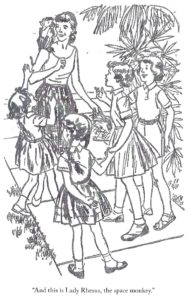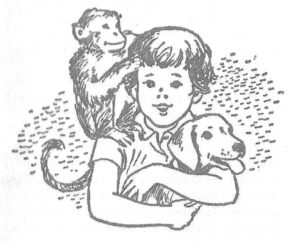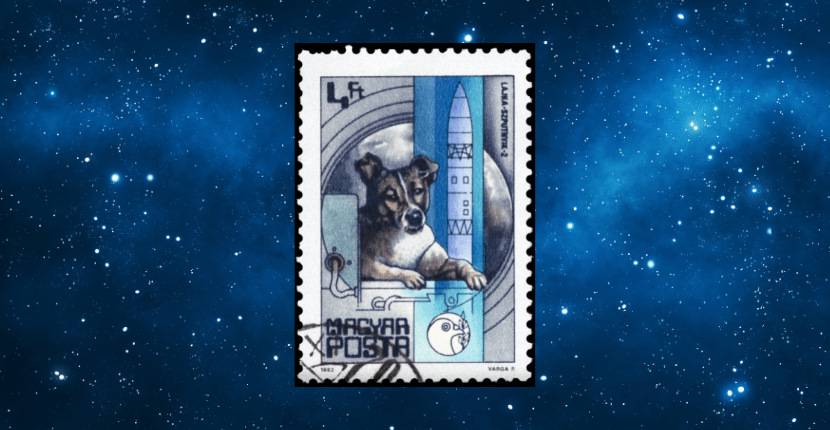You’ve heard of famous astronauts like Neil Armstrong, Sally Ride, and Yuri Gagarin, but how about Laika the dog or Miss Baker the monkey? Animal astronauts might seem like a strange thought, but animal space explorers played a key role in helping humans get to the moon and beyond, as the Hollister family learns when they befriend Lady Rhesus, the “space monkey” in The Happy Hollisters and the Mystery at Missile Town by Jerry West. 
In the early days of space exploration, when scientists from the United States and the Soviet Union were racing to get humans into space, animals were used to evaluate everything from spacecraft safety to the effects of microgravity. Among the first creatures to venture beyond our atmosphere were fruit flies, who were first launched into space by the U.S. in 1947. The flies, which were used to test for radiation exposure, went about 68 miles into space, and were recovered alive after being ejected via a parachute.
A few years later, in 1949, a Rhesus monkey named Albert II earned the distinction of becoming the first mammal to ever go to space, although he unfortunately died upon reentry into the Earth’s atmosphere. After Albert II, the U.S. launched several more animals into space, including other monkeys, mice, and frogs. A squirrel monkey named Miss Baker became the first monkey to survive a spaceflight in 1959. During her mission, which launched from Cape Canaveral in Florida, Miss Baker experienced speeds of up to 9,900 miles per hour and was likely weight loss for about nine minutes of her sixteen-minute flight. After returning safely to Earth, she was celebrated for her achievements and went on to live for another twenty-five years. She is probably the inspiration for Lady Rhesus, who is happily retired in Florida and plays an important part in The Happy Hollisters and the Mystery at Missile Town.
Many animals also helped the Soviet Union put the first human into space in 1961 during the “space race.” The most famous of these is Laika, a stray dog who became the first living creature to orbit Earth in 1957. Chosen because her days as a stray gave her the endurance to survive the harsh extremes of space travel. Laika underwent intense training before her mission aboard Sputnik 2. Laika’s incredible story is also a tragic one, as the scientists behind her mission knew that Sputnik 2 would be unretrievable. Though she died during her mission, Laika is honored today as a pioneer of space exploration, but her inhumane treatment also became a call to action for animal-rights activists around the world.
 All in all, more than thirty animals have been to space, with many of them serving in experiments that helped human astronauts reach incredible heights. A number of them survived their daring missions and were retired to live more peaceful post-flight lives with their trainers and handlers, like Lady Rhesus, who spends her days practicing fun tricks, enjoying the Florida sun, and making new friends like Pete, Pam, Ricky, Holly, and Sue Hollister.
All in all, more than thirty animals have been to space, with many of them serving in experiments that helped human astronauts reach incredible heights. A number of them survived their daring missions and were retired to live more peaceful post-flight lives with their trainers and handlers, like Lady Rhesus, who spends her days practicing fun tricks, enjoying the Florida sun, and making new friends like Pete, Pam, Ricky, Holly, and Sue Hollister.
by Libby Svenson Kennedy
Sources:
Research notes, Andrew Svenson Archives of The Hollister Family Properties Trust
https://history.nasa.gov/animals.html
http://laikamagazine.com/why-laika-the-space-dog-is-all-animals/

